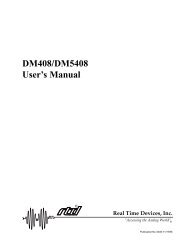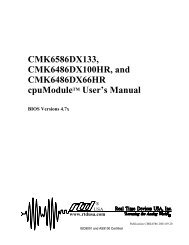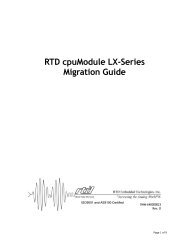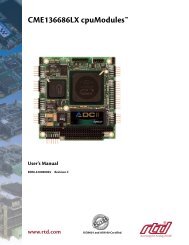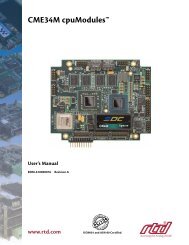cmd6686gx manual - RTD Embedded Technologies, Inc.
cmd6686gx manual - RTD Embedded Technologies, Inc.
cmd6686gx manual - RTD Embedded Technologies, Inc.
Create successful ePaper yourself
Turn your PDF publications into a flip-book with our unique Google optimized e-Paper software.
• Save your changes and exit Setup.<br />
• Turn off the cpuModule.<br />
• Install the memory device into the socket.<br />
• Reboot the cpuModule. The SSD should appear as the next available drive in your system.<br />
• Format the SSD using the DOS format command.<br />
• If you wish to boot from the SSD make it diskette A.<br />
Installing a Conventional SSD using SRAM or NOVRAM<br />
When the Solid State Disk is composed of SRAM or NOVRAM, it appears as a read/write disk and<br />
may be read and written using normal DOS disk commands.<br />
To install an SRAM or NOVRAM SSD, you should follow this procedure:<br />
• Apply power to the cpuModule and run Setup.<br />
• Set Diskette A or B to the appropriate SRAM or NOVRAM device type.<br />
• Set SSD Window to a value which will not conflict with other hardware or software.<br />
• Save your changes and exit Setup.<br />
• Turn off the cpuModule.<br />
• Install the memory device into the cpuModule socket.<br />
• Reboot the cpuModule. The SSD should appear as the next available drive in your system.<br />
• Format the SSD using the DOS format command.<br />
If you wish to make the SSD bootable, you must format it using the /s switch of the format command.<br />
Refer to your DOS <strong>manual</strong> for more information on the format command.<br />
If you wish to boot from the SSD make it diskette A.<br />
Notes on Formatting an SRAM or NOVRAM SSD<br />
For most purposes, you can format the SRAM or NOVRAM SSD as you would a 1.44MB floppy,<br />
using a command line similar to:<br />
format b: /u<br />
To get the most possible space in the disk and ensure proper operation, use the format command with<br />
a size parameter just over the total size of the installed SSD memory. For example, if you install 256<br />
Kbytes of SRAM, you should use format with the parameters for a 360 Kbyte floppy disk. For example:<br />
ROM-DOS:format b: /u /n:9 /t:40<br />
MS-DOS:format b: /f:360K<br />
See your DOS <strong>manual</strong> for details on the format command and its parameters.<br />
Installing a Conventional SSD using EPROM or Flash other than Atmel<br />
EPROMs or Flash EPROMs for an SSD must be programmed externally to the cpuModule, using<br />
an EPROM programmer and following the procedure below.<br />
To install an EPROM SSD, you should follow this procedure:<br />
• Apply power to the cpuModule and run Setup.<br />
• Set Diskette A or B to the appropriate EPROM or Flash type.<br />
• Set SSD Window to a value which will not conflict with other hardware or software.<br />
• Save your changes and exit Setup.<br />
• Follow the instructions for the RIMAGE program in the Phoenix BIOS Users Manual to<br />
create a file and program it into the device with your EPROM programmer.<br />
• Boot the cpuModule.<br />
After booting, the Solid State Disk will be seen by the system as a write-protected floppy. DOS commands<br />
normally used to read floppy disks will work with the SSD.<br />
96



